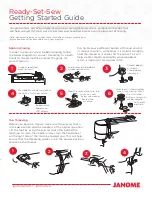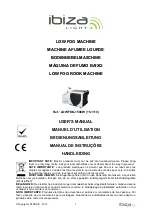
WHAT’S NEXT
janome.com • janome.ca
Page 3
Sewing Over Thick Fabrics
Even though sewing machines can handle all types
of fabrics, it’s important to keep in mind that when
sewing on thick fabrics like denim, that seams
can become very thick. It is important to keep the
presser foot level when sewing over these seams or
uneven surfaces.
Pro tip:
A quick fi x is to fold a scrap of fabric 2 - 3
times and put it behind the needle and underneath
the presser foot when you approach the seam or
hump in your fabric. This will help to level your foot
and keep your fabric feeding correctly.
The Thread Loops on the Underside or
Topside of the Fabric
Pro tip:
Problems with your seam are the opposite
of what you might think. If the thread is looping on
the underside of your seam, re-check the upper
threading on your machine. The thread may not be
correctly seated in the thread guides or has come
out of the Take Up lever.
Conversely, if the thread is looping on top, make
sure the bobbin thread is coming off the bobbin
counterclockwise and that the thread is securely
threaded in the bobbin tension guide.
Refer to your instruction manual for more
information.
Machine or Needle is Jammed
Using scissors, carefully cut away thread above and
below your fabric. Gently pull the fabric away from
the presser foot area, while making slight turns on
the handwheel to raise the needle.
Inspect the needle to make sure it isn’t bent. If so,
replace it. Before re-threading the needle, turn the
handwheel toward you, making sure that there isn’t
any more thread or fabric in the feed dogs or in the
bobbin area.
Pro tip:
When you are done sewing a seam, make
sure that the needle is in the highest position
before you remove your fabric from the machine.
This will ensure that that the upper thread has
made a full rotation around the bobbin case,
preventing thread jams in the bobbin area.
Machine Won’t Turn On
Check to make sure that the cord is plugged into
the wall.
Check to make sure that the power cord is plugged
into the sewing machine.
24
• Tension is too tight
q
Needle thread (Top thread)
w
Bobbin thread (Bottom thread)
e
To loosen
r
Right side (Top side) of fabric
t
Wrong side (Bottom side) of fabric
If the bobbin thread shows through on the right
side (Top side) of the fabric, and the stitch
feels bumpy, turn the dial to a lower tension
setting number to loosen the needle thread
tension.
1
3
2
Adjust the Needle Thread Tension for a
Straight Stitch
• Correct tension
q
Needle thread (Top thread)
w
Bobbin thread (Bottom thread)
e
To loosen
r
To tighten
The ideal straight stitch has threads locked
between two layers of fabric, as illustrated
(magnified to show detail). If you look at the
top and bottom of a seam, notice that there are
no gaps. Each stitch is smooth and even.
When adjusting the needle thread tension, the
higher the number, the tighter the needle
thread tension.
Results depend on:
- stiffness and thickness of the fabric
- number of fabric layers
- type of stitch
1
5
4
2
1
5
4
2
• Tension is too loose
q
Needle thread (Top thread)
w
Bobbin thread (Bottom thread)
e
To tighten
r
Right side (Top side) of fabric
t
Wrong side (Bottom side) of fabric
If the needle thread shows through on the
wrong side (Bottom side) of the fabric, and the
stitch feels bumpy, turn the dial to a higher
tension setting number to tighten the needle
thread tension.
3
4
3
6
Before Using Your Sewing Machine
Before using your sewing machine for the first
time, place a waste fabric under the presser foot
and run the machine with thread for a few
minutes. Wipe away any oil which may appear.
For Your Safety
* While in operation, always keep your eyes on
the sewing area. Do not touch any moving
parts, such as the thread take-up lever,
handwheel or needle.
* Always turn off the power switch and unplug
from the power supply:
- When leaving the machine unattended
- When attaching or removing any parts
- When cleaning the machine
* Do not place anything on the foot control,
when not sewing.
SECTION II. GETTING READY
TO SEW
Connecting Machine to Power Supply
q
Power supply plug
w
Power switch
e
Outlet
r
Machine socket
t
Machine plug
Before connecting the power cord, make sure
the voltage and frequency shown on the ma-
chine conform to your electrical power.
1. Turn off the power switch
w
.
2. Insert the machine plug
t
into the machine
socket
r
.
3. Insert the power supply plug
q
into the outlet
e
.
4. Turn on the power switch
w
to activate the
power and sewing light.
q
e
w
r
t
Controlling Sewing Speed
Sewing speed can be varied by the foot control.
The harder you press on the foot control, the
faster the machine runs.
Polarized plug
This appliance has a polarized plug (one blade wider
than the other). To reduce the risk of an electric
shock, this plug is intended to fit in a polarized outlet
only one way. If the plug does not fit in the outlet,
reverse the plug. If it still does not fit, contact a
qualified electrician to install the proper outlet. Do not
modify the plug in any way.
Foot Controller Model YC-482J-1 or TJC-150 is used
with this sewing machine.
Correct tension
Common Sewing Situations






















